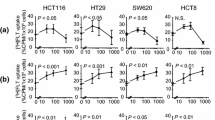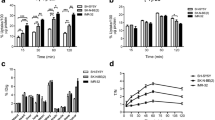Abstract
Purpose
To compare the utility of a new artificial amino acid, O-[18F]fluoromethyl-L-tyrosine ([18F]FMT), for monitoring cancer chemotherapy with deoxyglucose and thymidine.
Methods
[18F]FMT, [14C]deoxyglucose ([14C]DG) and [6-3H]thymidine ([3H]Thd) were applied in this study. A 2.5 mg/kg dose of mitomycin (MMC) was administered to AH272 rat hepatoma-bearing Donryu rats. Tumour uptake of each tracer was measured just before (baseline) and on days 1, 3, 5 and 7 after the MMC administration, 1 h after a mixture of [18F]FMT, [14C]DG and [3H]Thd had been injected, and was shown as DURs (% injected dose/gram tissue normalised for the rat body weight). Dual-tracer macroautoradiographs with [18F]FMT and [14C]DG were also prepared.
Results
The tumour uptake for each tracer decreased earlier than did the tumour size. DURs (mean±SD) at baseline and on days 1, 3, 5 and 7 were as follows: [18F]FMT: 4.68±0.72, 3.34±0.66, 3.13±0.72, 3.42±0.45, 3.01±0.32; [14C]DG: 3.26±0.40, 3.09±0.55, 3.01±0.97, 2.28±0.35, 1.70±0.72; and [3H]Thd: 2.23±0.46, 1.54±0.45, 1.28±0.37, 1.35±0.20, 0.94±0.12. Decrease in [18F]FMT uptake compared with baseline was significant from day 1 (p<0.01), and the decrease in [3H]Thd uptake was also significant on day 1 (p<0.05) and days 3–7 (p<0.01). However, decrease in [14C]DG uptake was only significant from day 5 (p<0.01). Macroautoradiography suggested that the influence of inflammatory cells on the accumulation of [18F]FMT in tumours is smaller than that on the accumulation of [14C]DG.
Conclusion
[18F]FMT uptake shows a rapid and sensitive response to chemotherapy, comparable to that of [3H]Thd, suggesting that it may be applied as a powerful tracer for monitoring of proliferative activity after cancer chemotherapy using PET.




Similar content being viewed by others
References
Warburg O. On the origin of cancer cells. Science 1956;123:309–14
Gambhir SS, Czernin J, Schwimmer J, Silverman DH, Coleman RE, Phelps ME. A tabulated summary of the FDG PET literature. J Nucl Med 2001;42:1S–93S
Kubota K, Ishiwata K, Kubota R, Yamada S, Tada M, Sato T, et al. Tracer feasibility for monitoring tumor radiotherapy: a quadruple tracer study with fluorine-18-fluorodeoxyglucose or fluorine-18- fluorodeoxyuridine, L-[methyl-14C]methionine, [6-3H]thymidine, and gallium-67. J Nucl Med 1991;32:2118–23
Yoshioka T, Takahashi H, Oikawa H, Maeda S, Ido T, Akaizawa T, et al. Influence of chemotherapy on FDG uptake by human cancer xenografts in nude mice. J Nucl Med 1997;38:714–7
Kostakoglu L, Goldsmith SJ. 18F-FDG PET evaluation of the response to therapy for lymphoma and for breast, lung, and colorectal carcinoma. J Nucl Med 2003;44:224–39
Kostakoglu L, Goldsmith SJ. PET in the assessment of therapy response in patients with carcinoma of the head and neck and of the esophagus. J Nucl Med 2004;45:56–68
Weber WA. Use of PET for monitoring cancer therapy and for predicting outcome. J Nucl Med 2005;46:983–95
Kubota R, Kubota K, Yamada S, Tada M, Ido T, Tamahashi N. Microautoradiographic study for the differentiation of intratumoral macrophages, granulation tissues and cancer cells by the dynamics of fluorine-18-fluorodeoxyglucose uptake. J Nucl Med 1994;35:104–12
Weber G. Biochemical strategy of cancer cells and the design of chemotherapy: G. H. A. Clowes Memorial Lecture. Cancer Res 1983;43:3466–92
Jager PL, Vaalburg W, Pruim J, de Vries EG, Langen KJ, Piers DA. Radiolabeled amino acids: basic aspects and clinical applications in oncology. J Nucl Med 2001;42:432–45
Langstrom B, Antoni G, Gullberg P, Halldin C, Malmborg P, Nagren K, et al. Synthesis of L- and D-[methyl-11C]methionine. J Nucl Med 1987;28:1037–40
Kubota K, Matsuzawa T, Ito M, Ito K, Fujiwara T, Abe Y, et al. Lung tumor imaging by positron emission tomography using C-11 L-methionine. J Nucl Med 1985;26:37–42
Leskinen-Kallio S, Lindholm P, Lapela M, Joensuu H, Nordman E. Imaging of head and neck tumors with positron emission tomography and [11C]methionine. Int J Radiat Oncol Biol Phys 1994;30:1195–9
Lindholm P, Leskinen S, Nagren K, Lehikoinen P, Ruotsalainen U, Teras M, et al. Carbon-11-methionine PET imaging of malignant melanoma. J Nucl Med 1995;36:1806–10
Jansson T, Westlin JE, Ahlstrom H, Lilja A, Langstrom B, Bergh J. Positron emission tomography studies in patients with locally advanced and/or metastatic breast cancer: a method for early therapy evaluation? J Clin Oncol 1995;13:1470–7
Sato N, Suzuki M, Kuwata N, Kuroda K, Wada T, Beppu T, et al. Evaluation of the malignancy of glioma using 11C-methionine positron emission tomography and proliferating cell nuclear antigen staining. Neurosurg Rev 1999;22:210–4
Laverman P, Boerman OC, Corstens FH, Oyen WJ. Fluorinated amino acids for tumour imaging with positron emission tomography. Eur J Nucl Med Mol Imaging 2002;29:681–90
Coenen HH, Kling P, Stocklin G. Cerebral metabolism of L-[2-18F]fluorotyrosine, a new PET tracer of protein synthesis. J Nucl Med 1989;30:1367–72
Ishiwata K, Enomoto K, Sasaki T, Elsinga PH, Senda M, Okazumi S, et al. A feasibility study on L-[1-carbon-11]tyrosine and L-[methyl-carbon-11]methionine to assess liver protein synthesis by PET. J Nucl Med 1996;37:279–85
Wester HJ, Herz M, Weber W, Heiss P, Senekowitsch-Schmidtke R, Schwaiger M, et al. Synthesis and radiopharmacology of O-(2-[18F]fluoroethyl)-L-tyrosine for tumor imaging. J Nucl Med 1999;40:205–12
Inoue T, Tomiyoshi K, Higuichi T, Ahmed K, Sarwar M, Aoyagi K, et al. Biodistribution studies on L-3-[fluorine-18]fluoro-alpha-methyl tyrosine: a potential tumor-detecting agent. J Nucl Med 1998;39:663–67
Kubota K, Matsuzawa T, Fujiwara T, Sato T, Tada M, Ido T, et al. Differential diagnosis of AH109A tumor and inflammation by radioscintigraphy with L-[methyl-11C]methionine. Jpn J Cancer Res 1989;80:778–82
Iwata R, Furumoto S, Pascali C, Bogni A, Ishiwata K. Radiosynthesis of O-[11C]methyl-L-tyrosine and O-[18F]fluoromethyl-L-tyrosine as potential PET tracers for imaging amino acid transport. J Label Compd Radiopharm 2003;46:555–66
Ishiwata K, Kawamura K, Wang WF, Furumoto S, Kubota K, Pascali C, et al. Evaluation of O-[11C]methyl-L-tyrosine and O-[18F]fluoromethyl-L-tyrosine as tumor imaging tracers by PET. Nucl Med Biol 2004;31:191–98
Kubota K, Matsuzawa T, Takahashi T, Fujiwara T, Kinomura S, Ido T, et al. Rapid and sensitive response of carbon-11-L-methionine tumor uptake to irradiation. J Nucl Med 1989;30:2012–016
Rau FC, Weber WA, Wester HJ, Herz M, Becker I, Kruger A, et al. O-(2-[18F]fluoroethyl)-L-tyrosine (FET): a tracer for differentiation of tumour from inflammation in murine lymph nodes. Eur J Nucl Med Mol Imaging 2002;29:1039–46
Suzuki M, Yamaguchi K, Honda G, Iwata R, Furumoto S, Jeong MG, et al. An experimental study on O-[18F]fluoromethyl-L-tyrosine for differentiation between tumor and inflammatory tissues. Ann Nucl Med 2005;19:589–95
Kubota R, Kubota K, Yamada S, Tada M, Ido T, Tamahashi N. Active and passive mechanisms of [fluorine-18] fluorodeoxyglucose uptake by proliferating and prenecrotic cancer cells in vivo: a microautoradiographic study. J Nucl Med 1994;35:1067–75
Haberkorn U, Bellemann ME, Brix G, Kamencic H, Morr I, Traut U, et al. Apoptosis and changes in glucose transport early after treatment of Morris hepatoma with gemcitabine. Eur J Nucl Med 2001;28:418–25
Iwata R, Pascali C, Bogni A, Furumoto S, Terasaki K, Yanai K. [18F]fluoromethyl triflate, a novel and reactive [18F]fluoromethylating agent: preparation and application to the on-column preparation of [18F]fluorocholine. Appl Radiat Isot 2002;57:347–52
Shields AF, Grierson JR, Dohmen BM, Machulla HJ, Stayanoff JC, Lawhorn-Crews JM, et al. Imaging proliferation in vivo with [F-18]FLT and positron emission tomography. Nat Med 1998;4:1334–336
Buck AK, Halter G, Schirrmeister H, Kotzerke J, Wurziger I, Glatting G, et al. Imaging proliferation in lung tumors with PET: 18F-FLT versus 18F-FDG. J Nucl Med 2003;44:1426–31
Waldherr C, Mellinghoff IK, Tran C, Halpern BS, Rozengurt N, Safaei A, et al. Monitoring antiproliferative responses to kinase inhibitor therapy in mice with 3′-deoxy-3′-18F-fluorothymidine PET. J Nucl Med 2005;46:114–20
Pauleit D, Stoffels G, Schaden W, Hamacher K, Bauer D, Tellmann L, et al. PET with O-(2-18F-fluoroethyl)-L-tyrosine in peripheral tumors: first clinical results. J Nucl Med 2005;46:411–6
Acknowledgements
This work was supported by Grants-in-Aid for Scientific Research (No. 13670910) from the Ministry of Education, Science, Sports, Culture and Technology, and for Cancer Research (11S-3) from the Ministry of Health, Labor, and Welfare, Japan.
Author information
Authors and Affiliations
Corresponding author
Rights and permissions
About this article
Cite this article
Yamaura, G., Yoshioka, T., Fukuda, H. et al. O-[18F]fluoromethyl-L-tyrosine is a potential tracer for monitoring tumour response to chemotherapy using PET: an initial comparative in vivo study with deoxyglucose and thymidine. Eur J Nucl Med Mol Imaging 33, 1134–1139 (2006). https://doi.org/10.1007/s00259-006-0126-2
Received:
Accepted:
Published:
Issue Date:
DOI: https://doi.org/10.1007/s00259-006-0126-2




